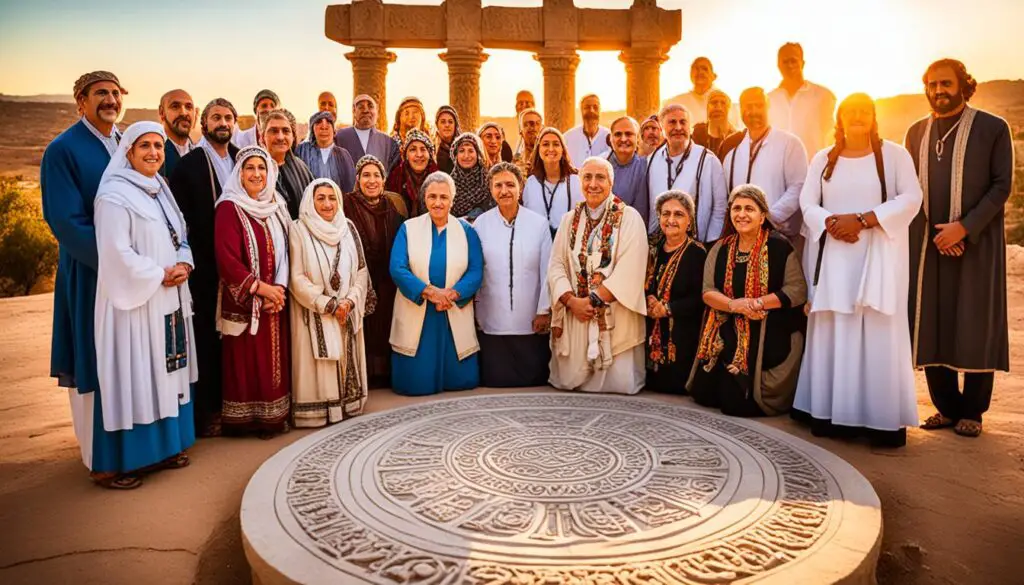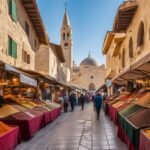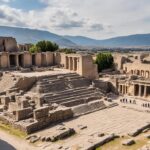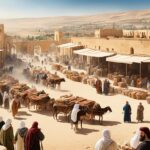Discover the fascinating historical and spiritual significance of Ramah in the Bible. This ancient town is mentioned in various Old Testament texts and holds a special place in biblical narratives, cultural practices, and theological themes. Uncover the hidden secrets of Ramah and gain a deeper understanding of its historical context and interpretation in biblical stories.
Key Takeaways:
- Ramah has significant historical and spiritual importance in the Bible.
- It is mentioned in various Old Testament texts and is associated with key biblical events, cultural practices, and theological themes.
- Archaeological excavations have provided further insights into the location and significance of Ramah.
- Ramah is believed to have been located in modern-day Israel, specifically in the region of Benjamin.
- The mentions of Ramah in the Bible provide glimpses into the cultural and religious practices of the Israelites during that time.
The Historical Significance of Ramah
Ramah holds historical significance in the Bible as it is mentioned multiple times in the Old Testament. It is associated with the hometown of the prophet Samuel and is referenced in relation to important events and figures in biblical narratives.
One significant mention of Ramah in the Old Testament is in 1 Samuel 1:1, where it is described as the birthplace of Samuel, one of the most prominent prophets in Israelite history. Samuel’s upbringing and early ministry in Ramah played a crucial role in shaping the nation of Israel.
The biblical references to Ramah not only provide insights into its historical context but also shed light on the role it played in ancient Israelite society. Ramah served as an important religious and cultural center, where sacrifices and offerings were made to the Lord.
“And Elkanah went to his house at Ramah. But the child ministered unto the Lord before Eli the priest.” – 1 Samuel 2:11
Furthermore, Ramah is associated with other significant biblical events, including the anointing of King Saul as the first king of Israel. In 1 Samuel 10:2, the prophet Samuel directs Saul to pass through the town of Ramah. This event marked a pivotal moment in Israel’s history and the establishment of the monarchy.
The historical significance of Ramah extends beyond the narratives involving Samuel and King Saul. Ramah’s strategic location and its relation to other prominent cities, such as Jerusalem and Bethlehem, make it an important reference point in the Old Testament.
The mentions of Ramah in the Bible provide valuable historical insights into the ancient Israelite society, its religious practices, and the significant events that unfolded in and around Ramah. Exploring Ramah’s historical significance deepens our understanding of biblical narratives and the cultural context in which they took place.
The Geographical Location of Ramah
Ramah, an ancient city mentioned in the Bible, is believed to have been situated in modern-day Israel, specifically in the region of Benjamin. The exact location of Ramah is a topic of debate among scholars, but it is generally understood to have been a town strategically positioned on a hill.
The geographic setting of Ramah played a significant role in its biblical prominence. Its elevated vantage point made it an ideal location for defensive purposes and provided a commanding view of the surrounding areas. This strategic position likely influenced the city’s role in various biblical narratives and its historical significance.
To better understand the geographical context of Ramah, it is important to consider the broader landscape of ancient Israel. Ramah would have been located within close proximity to other towns and cities, contributing to its regional importance and potential interactions with neighboring communities.
While the precise location of Ramah remains contested, archaeological excavations and biblical references provide valuable insights into the historical and geographic significance of this ancient city. These sources combined allow us to paint a more comprehensive picture of Ramah and its role in biblical history.

| Biblical References | Historical Context |
|---|---|
| Ramah is mentioned in the context of Saul’s anointing as the first king of Israel. | The anointing of Saul marks a pivotal moment in Israelite history, leading to the establishment of a monarchy. |
| Ramah is associated with Samuel, a significant figure in Israelite history and the last of the judges. | Samuel’s prophetic ministry and his role in anointing Saul and later David contribute to Ramah’s importance in religious and political narratives. |
| Ramah is mentioned in the context of Jeremiah’s prophecy of Rachel weeping for her children. | This prophecy symbolizes mourning and lamentation for the future exile of the Israelites and reflects the tumultuous times in which Ramah existed. |
Archaeological Discoveries in Ramah
Archaeological excavations in the area believed to be the location of Ramah have provided fascinating insights into its historical and cultural significance in biblical times. These discoveries shed light on the rich history of Ramah and add depth and authenticity to our understanding of this ancient city as it is described in the Old Testament.
Through meticulous excavation and analysis, archaeologists have unearthed a wealth of artifacts and structures that offer valuable clues about the daily life and practices of the people who once inhabited Ramah.
Ancient structures, including walls, houses, and administrative buildings, have been discovered, providing evidence of a vibrant and organized community. These architectural remains offer glimpses into the urban layout and construction practices of the time.
Pottery fragments found at the excavation site reveal the artistic skills and craftsmanship of the ancient Ramahites. The variety of pottery types and styles found at Ramah indicates its active trade connections with neighboring regions, offering valuable insights into the economic and cultural interactions of the time.
Additionally, various other artifacts, such as jewelry, tools, and religious objects, have been uncovered, providing a glimpse into the daily lives, customs, and religious practices of the inhabitants. These findings help paint a vivid picture of the ancient Ramahite society and its connections to the broader ancient Near Eastern world.
“The archaeological discoveries at Ramah offer a tangible connection to the biblical narratives and allow us to explore the material culture of the people who lived during that era.” – Professor Sarah Davis, Archaeologist
Examples of Archaeological Discoveries in Ramah
| Artifact | Description |
|---|---|
| Ancient Walls | Remains of fortified walls that enclosed the city, providing insights into the defensive strategies of the time. |
| House Foundations | Structural remains of houses, revealing details about domestic life and the architectural styles of ancient Ramah. |
| Pottery | Fragments of pottery vessels showcasing the artistic tradition and trade connections of the ancient Ramahite society. |
| Jewelry | Personal adornments such as earrings, bracelets, and rings, offering insights into the fashion and status symbols of the time. |
| Religious Objects | Ceremonial artifacts and religious symbols, highlighting the spiritual beliefs and practices of the ancient Ramahites. |
The archaeological discoveries in Ramah contribute to our understanding of its history within the biblical context. They allow us to bridge the gap between the words of the Old Testament and the tangible remains of the ancient world, providing a more comprehensive picture of the past and serving as a testament to the authenticity and relevance of Ramah in biblical narratives.
Theological Themes in Ramah
Ramah, as mentioned in the Bible and referred to in various religious texts, holds significant theological significance. The narratives surrounding Ramah delve into essential themes that play a crucial role in shaping our understanding of the broader biblical narrative.
Prophetic Activity and Divine Revelation: Ramah is often linked with prophetic activity, serving as a backdrop for divine revelations. The encounters between prophets and God in Ramah exemplify the communication channels established between humans and the divine realm.
Repentance and Restoration: Furthermore, Ramah signifies the theme of repentance and restoration. Through the biblical accounts, we witness instances where individuals and communities in Ramah seek forgiveness and turn towards the path of righteousness to experience divine healing and reconciliation.
Fulfillment of God’s Promises: The narratives involving Ramah bring to light the fulfillment of God’s promises. Ramah’s association with significant events and figures serves as a testament to the faithfulness of God in fulfilling his divine plans and prophecies.
“Ramah stands as a testament to the divine revelation, repentance, and the fulfillment of God’s promises in the biblical narrative.”
The theological themes embedded within the narratives of Ramah contribute to a comprehensive understanding of the spiritual journey depicted in the Bible. By exploring the theological implications of Ramah, we gain insight into the divine-human relationship, the complexity of repentance and restoration, and the faithfulness of God in fulfilling his promises.

| Key Theological Themes in Ramah |
|---|
| Prophetic Activity and Divine Revelation |
| Repentance and Restoration |
| Fulfillment of God’s Promises |
Key Biblical Events in Ramah
Ramah, a significant location in the Bible, is closely associated with several key biblical events. These events provide insights into the rich tapestry of biblical history and the role that Ramah played in shaping the narrative.
The Birth and Anointing of King Saul
One notable biblical event that took place in Ramah is the birth and anointing of King Saul. According to the Old Testament, Samuel, the prophet, was instructed by God to anoint Saul as the first king of Israel. This momentous occasion occurred in Ramah, marking the beginning of a new era for the Israelites.
Samuel’s Prophetic Ministry
Ramah also serves as the backdrop for the beginning of Samuel’s prophetic ministry. Samuel, who grew up in Ramah, received his calling as a prophet at a young age. His ministry in Ramah played a crucial role in guiding the nation of Israel and delivering divine messages to its people.
Jeremiah’s Prophecy of Rachel Weeping for Her Children
Ramah is mentioned in the narratives of the prophet Jeremiah, specifically in relation to his prophecy of Rachel weeping for her children. This prophecy speaks of the mourning and sorrow that would come upon the people of Israel due to their disobedience and exile. Ramah thus becomes a symbol of grief and lamentation, representing the suffering of the nation.
“The birth and anointing of King Saul, Samuel’s prophetic ministry, and Jeremiah’s prophecy of Rachel weeping for her children are pivotal moments in biblical history that took place in Ramah.”
These biblical events associated with Ramah highlight its significance and role within the larger biblical narrative. They provide glimpses into the lives of key figures such as Samuel, Saul, and Jeremiah, and offer valuable insights into the historical and spiritual context of ancient Israel.

| Event | Significance |
|---|---|
| Birth and Anointing of King Saul | Marked the beginning of monarchy in Israel |
| Samuel’s Prophetic Ministry | Guided the nation of Israel and delivered divine messages |
| Jeremiah’s Prophecy of Rachel Weeping | Foretold the nation’s suffering and exile |
Table: Key Biblical Events in Ramah
Cultural and Religious Practices in Ramah
The mentions of Ramah in the Bible provide glimpses into the cultural and religious practices of the Israelites during that time. Ramah was a center for worship and religious ceremonies, reflecting the broader religious landscape of ancient Israel.
One of the key religious practices associated with Ramah is sacrifices and offerings. In the Old Testament, Ramah is often mentioned in the context of these rituals, suggesting that it played a significant role in the religious life of the Israelites.
“And Samuel judged Israel all the days of his life. And he went from year to year in circuit to Bethel, and Gilgal, and Mizpeh, and judged Israel in all those places. And his return was to Ramah; for there was his house; and there he judged Israel; and there he built an altar unto the Lord.” (1 Samuel 7:15-17)
This biblical passage indicates that Ramah was not only a place of judgment and governance but also a site for building altars and offering sacrifices to the Lord. This highlights the religious significance of Ramah in ancient Israel.
The mention of Ramah in relation to prophets also emphasizes its role as a religious center. Prophets, such as Samuel, were closely associated with Ramah and were instrumental in communicating God’s messages and directions to the Israelites.
The cultural practices in Ramah would have included various traditions and customs related to worship, music, and communal gatherings. These practices would have shaped the identity and spirituality of the Israelite community that resided in Ramah.

Prophetic and Eschatological Significance of Ramah
Ramah holds profound prophetic and eschatological significance in the biblical texts. It is intricately linked to prophecies that pertain to judgment, restoration, and the advent of the Messiah. The mentions of Ramah in the context of prophetic visions and messages contribute to the overarching prophetic narrative of the Bible, illuminating its crucial role in the divine plan for salvation.

Throughout the religious texts, Ramah is associated with significant prophetic utterances that embody divine revelations and foretell future events. These prophetic references underscore the profound importance of Ramah within the biblical framework, highlighting its connection to the unfolding divine plan and the fulfillment of divine prophecies.
Ramah’s prophetic significance can be traced to various passages in the Bible. One notable example is found in the Book of Jeremiah, where Ramah is mentioned in the prophecy of Rachel weeping for her children. This poignant passage foreshadows the exile and suffering of the Israelites, ultimately pointing towards restoration and hope.
“Thus says the Lord: A voice is heard in Ramah, lamentation and bitter weeping. Rachel is weeping for her children; she refuses to be comforted for her children because they are no more.” – Jeremiah 31:15
Ramah’s prophetic importance extends beyond singular passages, intertwining with broader eschatological themes throughout the Bible. It serves as a symbol of God’s ultimate judgment and restoration, illustrating the divine plan for the redemption and salvation of humanity.
The Role of Ramah in Eschatology
In eschatological terms, Ramah represents a significant milestone in the unfolding of God’s plan for humanity. It stands as a beacon of divine intervention and serves as a backdrop for the fulfillment of messianic prophecies. The coming of the Messiah and the establishment of God’s Kingdom are closely tied to the prophetic significance of Ramah, evoking a sense of anticipation and hope for believers.
Moreover, Ramah’s prophetic and eschatological significance underscores the interconnectedness of biblical narratives and the overarching themes of judgment, restoration, and redemption. It reinforces the cohesion and divine intentionality of the biblical text as a comprehensive revelation of God’s plan for humanity’s salvation.
| Prophetic Themes Associated with Ramah | Biblical References |
|---|---|
| Judgment and Consequence | Jeremiah 31:15 |
| Hope and Restoration | Jeremiah 31:16 |
| Divine Intervention | Matthew 2:17-18 |
| Messianic Fulfillment | Matthew 2:18 |
| Significance of Place and Setting | Various biblical passages |
This comprehensive table highlights the diverse prophetic themes associated with Ramah and their corresponding biblical references. It showcases the multi-faceted nature of Ramah’s significance within the prophetic and eschatological landscape of the Bible.
By understanding the prophetic and eschatological significance of Ramah, we gain a deeper appreciation for the intricate tapestry of biblical narratives and its profound implications for believers. Ramah serves as a testament to God’s divine plan, his faithfulness to his promises, and the promise of ultimate restoration through the coming of the Messiah.
Ramah in Contemporary Interpretation
The interpretation of Ramah in contemporary biblical scholarship and religious teachings varies. Different scholars and theologians offer diverse insights and perspectives on the role and meaning of Ramah in biblical narratives. These interpretations contribute to ongoing discussions and debates about the significance and relevance of Ramah in the present-day understanding of the Bible.
Conclusion
In conclusion, Ramah plays a significant role in biblical history, encompassing its historical, geographical, and theological importance. Through its association with key events, cultural practices, and prophetic themes, Ramah serves as a crucial backdrop in the biblical narrative.
The archaeological discoveries in the region where Ramah is believed to have existed further enhance our understanding of its historical context. These findings provide tangible evidence that aligns with the biblical accounts, reinforcing the authenticity of Ramah’s presence in biblical times.
The interpretations and discussions surrounding Ramah highlight the ongoing exploration and interpretation of the Bible. By delving into the multifaceted dimensions of Ramah, we gain deeper insights into the richness and complexity of the biblical stories. Ramah’s enduring religious impact continues to inspire and spark meaningful conversations within the religious community and biblical scholarship.
Overall, Ramah’s inclusion in the Bible, its significance in historical and theological contexts, and its interpretation in biblical stories contribute to a more comprehensive understanding of the biblical narrative as a whole.







